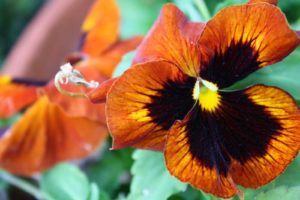

by Lydia Holley November 21 , 2022
Pansies are the jesters of the winter garden, with their cheerful faces every child adores seeing. They laugh in the face of winter, and dress in a variety of color combinations. Pansies are a hybrid of Viola (Viola x wittrockiana), bred for over 200 years in order to achieve the face which makes them famous, multiple colors, a larger-sized bloom, and even recently some with crinkled edges on their petals. Another recent development is the loss of their ‘face’ which makes them so recognizable, should you want a more sophisticated look.
Although Pansies may bloom for up to six months out of the year, they may not bloom consistently. They will go dormant in very cold weather, blooming again when temperatures become milder. They are the perfect annual plant for winters in East Texas since they can survive temperatures below 0 degrees F.
Pansies have large blooms while the blooms of Johnny Jump Ups are tiny. Johnny Jump Ups (Viola cornuta or v. tricolor) are also used as a winter annual in East Texas. You will find in spring, however, Johnny Jump Ups will tolerate more heat.
Both Pansies and Johnny Jump Ups can be susceptible to fungus. It is recommended that you not plant them in the same soil more than three years in a row. Still, you can place them in containers or move them around various areas as a bedding plant to give your garden color throughout the winter.
They are best planted in East Texas during the months of October, November, December, or February. Because they come in such a wide variety of blue, purple, white, yellow, and bronze, sometimes the hardest thing about growing Pansies and Johnny Jump Ups is deciding which color to choose. If you find it impossible, you can also purchased them in mixed shades.
Add a little fun to your garden this winter by planting Pansies, Johnny Jump Ups, or both. Their faces will bring a smile to yours and add a bit of cheer in the coldest season of the year.
For more information, call 903-675-6130, email hendersonCMGA@gmail.com.
Follow us on Facebook: https://www.facebook.com/HCmastergardener.